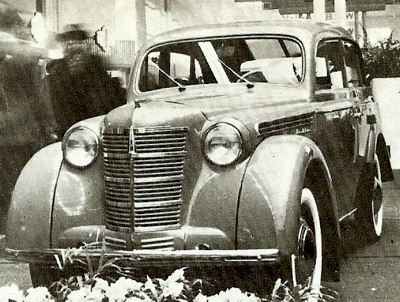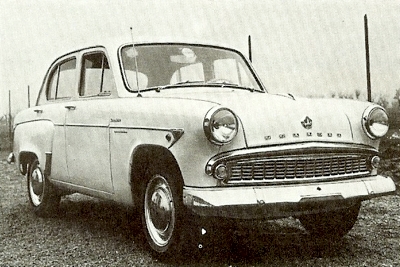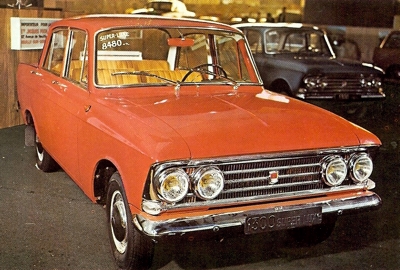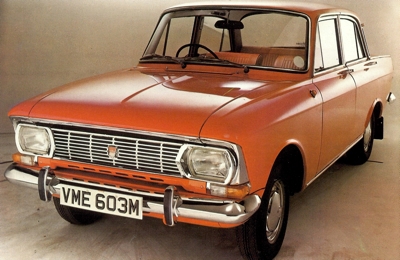TAKEN LITERALLY, THE NAME MOSKVICH means 'Son of Moscow' and it was in Moscow in 1947 that the Moskovskii Zavod Malitrajnikh Automobilie factory was established to manufacture passenger cars.
Although it was relatively late in the development of the motor car, the Moscow factory was the second oldest car production facility in Russia, the first being the Gorky factory which produces Volga cars. The first car which the factory produced was, in fact, manufactured from the dies which the Russians obtained from the German Adam Opel AG factory when the end of World War 2 brought about the enforced dismantling of the Russelsheim factory during 1945.
The Moskvich 400
Called the Moskvich 400, this model was consequently identical to the pre-war Opel Kadett. Powered by a four-cylinder engine, which produced 23 bhp, it was uprated in 1954 by three horsepower to become the Moskvich 401.
Two years later, the body was restyled to give birth to the Moskvich 402 and the engine power was increased to 35 bhp at 4200 rpm. At the same time, a four-wheel-drive 410 version was introduced.
In 1958, the Russian factory produced the 45 bhp 407 range which had, as well as the saloon, station-wagon, ambulance, taxi, delivery-van and four-wheel-drive derivatives. Five years later, with the 407 still in production, a new model, the 403 saloon, was introduced and it too had delivery-van and station-wagon derivatives, although from a stylistic point of view the differences to the previous model were largely in the trim rather than anywhere else.
In 1966, the more radically changed 408 models were launched. A five seater, the saloon version was powered by a four-cylinder, 1.4-liter, overhead-valve engine, which produced 60 bhp. Suspension was independent at the front, while the rear was mounted via conventional leaf springs.
Transmission was through a four-speed, fully synchromeshed gearbox. Station-wagon and delivery-van versions were produced and for the first time the cars were offered with optional extras such as twin headlamps, sun visors and electric windscreen washers.
The Moskvich 412
Early 1968 saw the announcement of the 412 series, powered by a 1480 cc, overhead-camshaft engine, which produced 80 bhp. This was basically the engine which powers the 412 in 1977. The Moskvich 1500 range, introduced in May 1974, was an improved version of the original 412, with a new radiator grill, new fascia and an improved braking system. With estate and delivery-van derivatives, the car was still powered by the four-cylinder, 1478 cc, overhead-camshaft, in-line, five-bearing-crankshaft unit which produced 80 bhp (SAE) at 5800rpm, giving a top speed of 90 mph.
 1951 Moskvich 400, the first the company produced, and based on dies taken from the German Adam Opel AG factory in 1945.
1951 Moskvich 400, the first the company produced, and based on dies taken from the German Adam Opel AG factory in 1945.
 This is a Moskvich Scaldia, build in Belgium and powered by a 1760cc Perkins diesel engine, which produced 62 bhp @ 4000 rpm.
This is a Moskvich Scaldia, build in Belgium and powered by a 1760cc Perkins diesel engine, which produced 62 bhp @ 4000 rpm.
 1968 Moskvich 412, powered by an overhead cam 80bhp 1478cc engine. It was also available as a wagon or delivery van.
1968 Moskvich 412, powered by an overhead cam 80bhp 1478cc engine. It was also available as a wagon or delivery van.
 1973 Moskvich 412, powered by a four-stroke four-cylinder 1478cc engine developing 80bhp at 5800 rpm. It was also available with a British built Perkins 1760cc diesel engine.
1973 Moskvich 412, powered by a four-stroke four-cylinder 1478cc engine developing 80bhp at 5800 rpm. It was also available with a British built Perkins 1760cc diesel engine. |
The engine had a compression ratio of 8.8: 1 and a twin-choke down-draught carburetor. Transmission was through a centrally mounted, four-speed, all-synchromesh gearbox and a single-plate diaphragm clutch. Servo-assisted drum brakes were fitted all round. Steering was by globoid worm and roller. Standard features of the car included heater, two-speed wipers, fully reclining front seats, burst-proof locks and a cigar lighter.
All models featured laminated windscreens, collapsible steering columns, dished steering wheels and padded dashboards. The Moskvich 1500 five-door estate was powered by the same engine as the saloon, which gave it the slightly slower top speed of 85 mph. The Moskvich 1500 three-door delivery-van had identical performance and technical characteristics to the estate. Diesel-engined versions of the 412 were first assembled in Belgium by Sobimpex and called the Scaldia. They were powered by the English Perkins 1760 cc diesel engine, which produced 62 bhp (SAE) at 4000 rpm and had a compression ratio of 22: 1, giving the car a top speed of 75 mph. This diesel engine was also available in the station-wagon version.
Capable Competitors
In the competition field Moskvich entries performed very creditably in the
London to Sydney Marathon in 1968, while three Moskvich saloons finished the gruelling, 16,000-mile Word Cup Rally of 1970. In 1972, a Moskvich driven by Tony Lanfranchi was entered in Group One of the British Saloon Car Racing Championship and performed so well that the car won both the Castrol and Britax sections of the Championship before the season was complete, as well as all the class prizes that year. This .success was repeated again in 1973.
In the Avon Motor Tour of Great Britain in July 1973, Moskvich entries took first, second, third and fourth places in their class. Moskvich vehicles were first imported into Britain in the middle of 1970 by Satra Motors Ltd, a subsidiary of the New York-based Satra Corporation. Satra had bought out, in June 1970, the previous company handling Soviet car imports in Britain, Thompson and Taylor (Russian Cars) Ltd, which had been formed in March 1960.
Sales rose from 300 units in 1969 to 14,500 in 1973. In the summer of 1975, Satra Motors ran-down its Moskvich operation. Despite the 412's unsophisticated charm and rugged reputation, Satra felt that the Russian Fiat-based Lada range offered even better value and sales potential. In 1977, there were no plans to re-introduce Moskvich to western Europe but in Russia 412 production continued unabated, and they were also produced in Bulgaria between 1966 and 1990 on the basis of complete knock down (CKD) kits.
Introduction of the Aleko 141
1986 saw the unveiling of a radically new (by Soviet standards) model, known as the Aleko-141. It was powered by the VAZ-2106 1.6L in-line four-cylinder engine, which had by then amassed an acceptable track record powering a number of Lada models. Aleko was a front-wheel drive hatchback different from any model the factory had made previously. It was larger and more luxurious, made with comfort, safety and aerodynamics in mind.
The body was built on the basis of
Simca 1307, while longitudinal engine placement and torsion-crank rear suspension and McPherson strut front suspension was inspired by Audi 80/100 family, while taking into account the larger size of the Moskvitch and Lada engines . The 1.8 liter gasoline engine for the new car was planned, but never materialized, as was also the case with a diesel version. The car was a major improvement over previous generations, but the fall of the centralised economy, below-par quality and inadequate management ultimately brought the factory to bankruptcy.
The factory, which had been renamed to OAO Moskvitch (Moskvitch Joint Stock Company) in the early 1990s, filed for bankruptcy in 2002 and ceased production. The factory remains idle and abandoned, everything left as it was in 2002. Unfinished bodyshells remain on the production line in various stages of completion, while furniture, computers, office supplies, and documents remain in the plant's administration building. Several attempts to restart production were made over the next 3 years, but none were successful.
